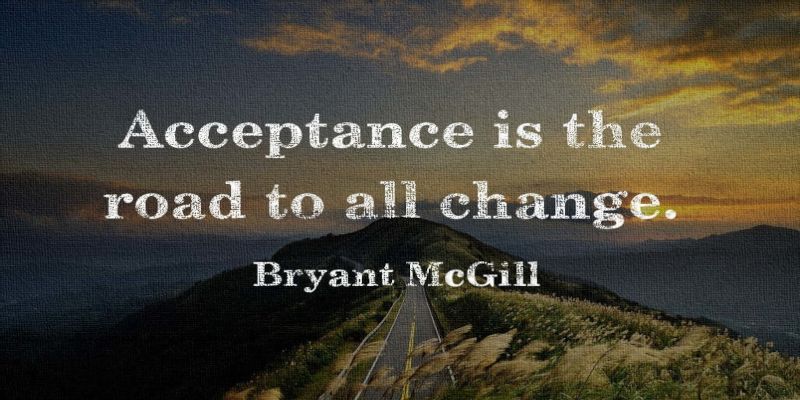Table of Contents
ToggleWe go through the cycle of grief and loss whenever we experience a tragic event. No matter how small, and in what area of life this traumatic episode happens.
We can feel sorrow over physical pain, but also over emotional traumatic experiences and losses. We can even feel them both at the same time.
Let me explain what the 5 stages of grief are in order.

Shock and denial
The first stage of grief is shock and denial.
After a traumatic event takes place, you’ll probably be in shock due to being overwhelmed by emotions and the large amount of stimuli around you.
You’re probably not able to comprehend and accept the full truth and depth of what has happened to you. As a result of being overcome by the shock of this painful experience, you’ll try to deny the harsh truth.
This is particularly the case if you didn’t foresee that the traumatic event was about to happen. For example, the loss of a loved one is always painful. But if you knew beforehand that this person was terminally ill, then you could at least prepare yourself slightly for the events that are imminent to happen. Thus, reducing the shock when it comes about.
Because of the shock of this negative occurrence, you may try to deny the reality that this happening brought with it. To go back to the example of the loved one you lost for a second, you may refuse and struggle to believe that your loved one is truly gone from existence.
This denial of reality may happen because you would be emotionally overwhelmed otherwise. So in a way, denial may be a natural process of your body to protect itself from further harm.
Pain and guilt

The second stage of grief is pain and guilt.
When the shock starts wearing off, reality starts kicking in. It’s then, and only then, that we start to realize what we have done or have gone through.
With the realization of the true depth of the traumatic event comes a lot of pain and as a result, guilt.
Some people may try to escape from this harsh reality by a variety of means such as alcohol, drugs, and sometimes, sadly enough, even suicide if the circumstances are excruciating and overbearingly painful.
Whatever you do, try not to fall prey to the victim mindset, since it’s a vicious circle that will only make matters worse rather than better. Sure, it might get you some attention at first, but it won’t help you to accept, or change things for that matter.
Anger and bargaining

All this pain, and frustration, coupled with an overall feeling of helplessness gives way to anger. While the realization has kicked in of what has happened, you still have a very hard time accepting it. This is why you try to bargain with reality.
“The relationship may not be the same after my partner cheated on me, but if I can trust them for 70 percent of how I used to trust them previously again, I’m satisfied.”
Previously, before the traumatic event took place, which in this specific case is cheating, you most likely wouldn’t have been satisfied with being able to trust your partner for just 70 percent.
However, after these circumstances, even being able to trust your partner 70 percent while maintaining the relationship sounds much more appealing rather than having to end the relationship. Granted, that is if you still love and value your partner.
Depression

You fully realize what you’ve lost and that there’s no way you can get it back, or fix it to the way it was before what happened.
This understanding makes you depressed because you’ve lost what little hope you previously had left to fix things to the way they were before.
That’s why you end up reflecting on the past even more, about what happened, and a feeling of helplessness may consequently overtake you.
This feeling of helplessness and the continuous reflection regarding what you’ve lost and how things used to make you fall into the abyss that is depression.
Acceptance

The final step in the cycle of grief is acceptance. When you reach this step, you have accepted whatever hurdle life has thrown at you, and you start seeing the beauty of life again while simultaneously moving forward once more. You are hopeful for the positive things that are yet to come in the future.
Even though you’ve lost something in one area of life, you realize that this may present opportunities in other aspects of your existence.
Physical and mental symptoms of depression start to decrease even more or fade away completely. You start to think of opportunities rather than problems.
You start to take ownership of your life again by improving the things that are under your control.
Note that reaching acceptance is not the same as having no concern or liking whatever has happened to you. It also doesn’t mean that you’ll never feel sad for whatever tragic event has befallen you, seeing as these are only normal human emotions that we all undergo at some point.
Not everyone who goes through the 5 stages of grief reaches this step. It’s possible to get stuck in one of the previous steps of the grieving process.
So yes, it’s possible to never reach the final step of the 5 stages of the grief model and as a result, never fully accept whatever tragic experience has happened to you.
What are the 5 stages of grief in chronological order?

The five stages of grief in chronological order are:
- Shock and denial
- Pain and guilt
- Anger and bargaining
- Depression
- Acceptance
Frequently Asked Questions (FAQ)
Are there 5 or 7 stages of grief?

Whether there are 5 or 7 stages of grief depends on which model you’re looking at.
Early on, psychiatrist Elisabeth Kübler-Ross identified only 5 stages of grief. She later rewrote this 5-phase model and changed it into a 7-stage framework that she deemed more appropriate to deal with the grieving process.
She wrote the original five-stage model down in 1969 in her book called, “On Death and Dying.” It entailed that dealing with sorrow is an emotional process that should be considered normal when managing suffering.
She and others also came to realize that people don’t grieve linearly and that they go in and out of the different stages in different ways and time frames. This also means that there is not one “right” way to grieve.
Because she didn’t want others to feel like they were not grieving correctly, she updated her original work to the current 7 stage grieving process, which includes shock and testing.
How long do the 5 stages of grief last?

Which stage of grief is the shortest?

Which stage of grief is the hardest?

Depression is considered the hardest stage of grief since it typically lasts the longest, and is the most difficult to deal with. That’s because it’s the phase where people truly experience the full depth of their pain.
Even so, every phase can be challenging, and not everyone deals with sorrow the same way. What might be the most difficult phase for me, might not be the hardest stage for you, and vice versa.
Can you skip the 5 stages of grief?
Is it true that grief never ends?

Conclusion

Grieving is a complicated process, wherein you can flow through a lot of different phases at the same time.
Some people may follow the five stages of grief in perfect chronological order, while others may skip steps, fall back to a previous phase, or go through multiple stages simultaneously.
That’s because the cycle of grief is a model and not an exact science. No person is the same. Thus, everyone goes through sorrow at their own pace, and in their way.





3 thoughts on “The 5 stages of grief explained”
Comments are closed.